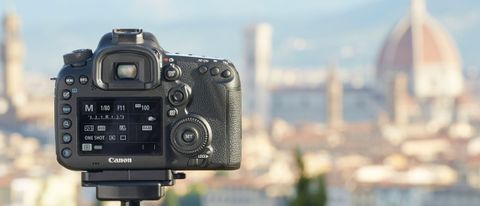Back in 2015, the Canon EOS 7D Mark II replaced the Canon EOS 7D. On its arrival, the EOS 7D Mark II assumed its place above the APS-C format Canon 70D and below the full-frame Canon EOS 5D Mark II. A lot of things have happened since then! The EOS 7D Mark II is still fast but now looks pretty dated in the Canon DSLR line-up... so is it still worth buying?
Technically, the EOS 7D Mark II still looks very effective as a camera for fans of sports photography, thanks to its tough, weatherproof build, 10fps continuous shooting and powerful AF system.
However, it is showing its age in other respects, with a fixed rear screen and no 4K video, and one of its twin card slots takes CF cards, which are mostly of historical interest today, while the other supports UHS-I SD cards but not UHS-II.
We can't really call it one of the best Canon cameras any more, and there are too many high-quality rivals to consider it one of the best cameras for professionals. For sports and action, though, it's arguably still one of the best cameras for enthusiasts.
• Read more: Canon EOS 90D vs EOS 80D vs EOS 7D Mark II
Specifications
Sensor: APS-C format 20.2MP CMOS
Focal length conversion: 1.6x
Memory: SD/SDHC/SDXC and CF
Viewfinder: Pentaprism with 100% coverage
Max video resolution: 1,920 x 1,080 pixels
ISO range: 100-16,000 (expandable to ISO 51,200)
Autofocus points: 65
Screen: 3-inch 1,040k-dot LCD
Shutter speeds: 30-1/8,000 sec plus Bulb
Weight: 820g (body only)
Dimensions: 148.8 x 112.4 x 78.2mm
Power supply: Rechargeable Li-ion LP-E6N battery (supplied)
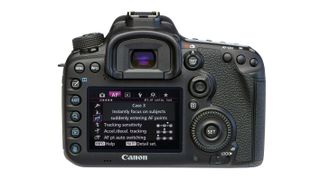
Key features
Inside the EOS 7D Mark II is a 20.2-megapixel sensor which is pretty modest by today's standards – though not in the pro sports market. The modest resolution allows faster continuous frame rates and better image quality at high ISO settings – both of which are top priorities for sports fans.
To achieve its maximum continuous shooting rate of 10 frames per second, the EOS 7D Mark II has two Digic 6 processing engines. When a UDMA 7 CF card (such as the Lexar Professional 1066x card) is installed, up to 31 raw files or 1,030 JPEGs can be shot in a single burst. If you need to shoot for more than 3.1 seconds, the High continuous shooting rate can be set between 2-10fps, while the Low rate can be set to 1-9fps and Silent mode to 1-4fps.
10fps was pretty hot when the EOS 7D Mark II was first introduced, but it's pretty common for cameras in this price range today. And while the 1,030 JPEG buffer capacity is great, the limit of 31 raw files in a burst is pretty low for a dedicated sports camera like this one.
The sensor and processing engine combination allows a native sensitivity range of ISO 100–16,000, with expansion settings going up to ISO 51,200. That's still pretty good for an APS-C format camera, even today.
The original EOS 7D had 19 autofocus points, all cross-type, while the Mark II has a class-leading 65 points; again, all are cross-type. This is very good, even today. With f/2.8 lenses, the central point is dual-cross type for extra sensitivity and is capable of operating when lens and teleconverter combinations take the effective aperture down to f/8.
It’s also possible to adjust tracking sensitivity, acceleration/deceleration tracking and AF point auto switching options. There are also seven AF point selection modes.
In Live View and video mode, the Dual Pixel AF system comes into play. Videographers will love the ability to slow the focusing down to produce a more cinematic transition, though without support for 4K video, the EOS 7D Mark II is unlikely to tempt many videographers today.
Other notable features include dual card slots (one SD/SDHC/SDXC, the other CompactFlash); an intervalometer for shooting time-lapse sequences; HDR mode (with raw file recording); multiple exposure mode; a built-in compass; and GPS to enable image geotagging. Sadly, there’s no Wi-Fi connectivity built in, though there is a plug-in Wi-Fi adaptor that's now being bundled with the camera in some cases.
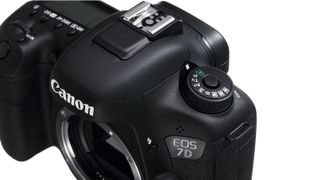
Build and handling
Canon retained the 7D’s magnesium alloy construction for the Mark II, but uprated its weather-proofing. The camera feels nice and solid, and the shutter has a claimed durability of 200,000 cycles. That's reassuring, but not unusual amongst this camera's rivals.
The grip on the front of the camera and the thumb-ridge on the back have an excellent textured coating, so they feel really secure in your hand. We found the thumb-ridge, which is thinner and more angular than the previous 7D’s, particularly good.

Owners of the original EOS 7D will find the EOS 7D Mark II familiar, but there are a few changes to the control layout. There are Rate and Creative Photo buttons, for example, as well as a new sprung selection lever around the mini-joystick control. This can be used to change the function of the main control dial in front of the shutter release on the top of the camera. We found it useful for accessing the sensitivity options.
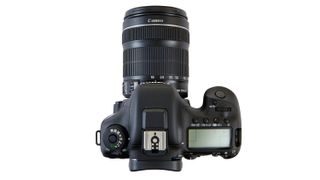
Performance
On the whole, the images and video the 7D Mark II produces look great straight from the camera. It’s also capable of resolving an impressive level of detail. Noise is also controlled well throughout the native sensitivity range, but as usual the expansion settings (which Canon considers not of sufficient quality for normal use) are best reserved for emergency situations or when images only need to be viewed at small sizes.

“The images and video the 7D Mark II produces look great straight from the camera”
JPEGs captured at the maximum expansion setting (ISO 51,200) have luminance noise visible at most normal viewing sizes, and some areas appear bruised with green and magenta.
Stepping down to the uppermost native setting (ISO 16,000) results in a significant improvement in image quality. When all noise reduction is turned off, ISO 16,000 raw files have a hint of colored speckling visible when sized to A3.
Zoom in to 100% and this chroma noise becomes very noticeable, but there’s still a respectable level of detail, so it’s possible to find a good balance between the two in post-processing.
At the other end of the sensitivity scale, there’s just a hint of luminance noise in some areas at 100% (even at ISO 100), but images have lots of detail visible.

One of things that impressed us most about the 7D Mark II during our testing is its new 252-zone metering system, which gathers data from a 150,000-pixel RGB and infrared sensor.
In the past, we have found Canon’s iFCL metering system a little frustrating in Evaluative mode: it can put too much weighting on the brightness of the subject under the active AF point, so you can end up with badly over- or under-exposed shots in high-contrast conditions. It acts more like centre-weighted metering than some other systems.
The metering system in the Mark II does a better job of taking the brightness of the whole scene into account. Naturally, there is still some weighting applied, but we found there are fewer occasions when exposure compensation is required.
That said, there seems to be a slight tendency towards bright images. Some of our landscapes shot in bright conditions look better when the exposure is reduced by about 1/3EV, either in-camera or post-capture.
The EOS 7D Mark II's autofocusing system doesn't disappoint. It’s both fast and accurate, and capable of working in very low light. It’s also complex, however, and takes some getting to know. Provided that you select the correct AF point selection mode and AF Al servo characteristics (which can be set via a selection of shooting scenario Case Studies), it does a great job.
We found Case 1 in the selection list a good starting point that worked well when shooting BMX riders in action.

In addition, the hybrid AF system, which is available when composing video or still images on the LCD screen in Live View mode is capable and able to find its target, even when you’re shooting in quite low light. With an STM lens mounted, there’s little back-and-forwards adjustment, even in fairly dull conditions. Although it’s quite a large camera to use held away from your body, it’s possible to use Live View when hand-holding the camera.
Switching from Standard to the slowest AF setting in the Movie Servo AF speed options has a significant impact upon the time the camera takes to focus the lens.
Either way, it moves the subject smoothly into focus. If you need to speed things up when using the slowest setting, however, pressing the AF-on button gets the subject sharp quickly.
Lab data
We compared our lab data for the Canon EOS 7D Mark II with the results from three modern rivals: the Canon EOS 90D (same frame rate, 50% more resolution), Nikon D7500 (not quite as fast, but a whole lot cheaper) and Sony A6400 (as an example of a high-speed modern mirrorless alternative).

Resolution
The Canon EOS 7D Mark II might have a modest resolution of just 20.2 million pixels, but it holds up pretty well against its rivals – the Nikon D7500 also has a 20MP sensor. Predictably, the 24MP Sony A6400 is a little sharper, and the 32.5MP EOS 90D is sharper still.

Signal to noise ratio
The EOS 7D Mark II may have an 'old' sensor but its modest resolution pays off and the camera still delivers very good noise performance right across the ISO range, narrowly beating all the modern rivals we compared it to.
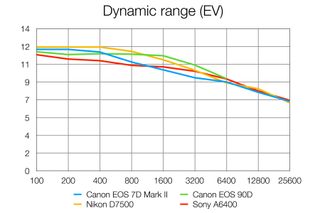
Dynamic range
The EOS 7D Mark II doesn't do quite so well in our dynamic range test. It performs pretty well up to ISO 400, but after that the newer EOS 90D and Nikon D7500 (though not the Sony A6400) are clearly better.
Verdict
The Canon EOS 7D Mark II might be quite old now, but it still has bags of appeal to the sports photography enthusiast wedded to the idea of an SLR rather than a compact system camera. The newer EOS 90D is more versatile, with a vari-angle screen, 4K video and much higher resolution, but even though it matches the 10fps frame rate of the older EOS 7D Mark II, it can't match its solidity or its 65-point AF system.
Having said that, the appeal of the 7D Mark II is narrowing. If you want a tough, fast and responsive DSLR for sports and action photography, it's still good, but for just about anything else there are newer, cheaper and better alternatives.
Read more:
• Canon EOS 90D review
• Canon EOS R review
• The best Canon camera: from DSLR to mirrorless to PowerShot and Ixus
